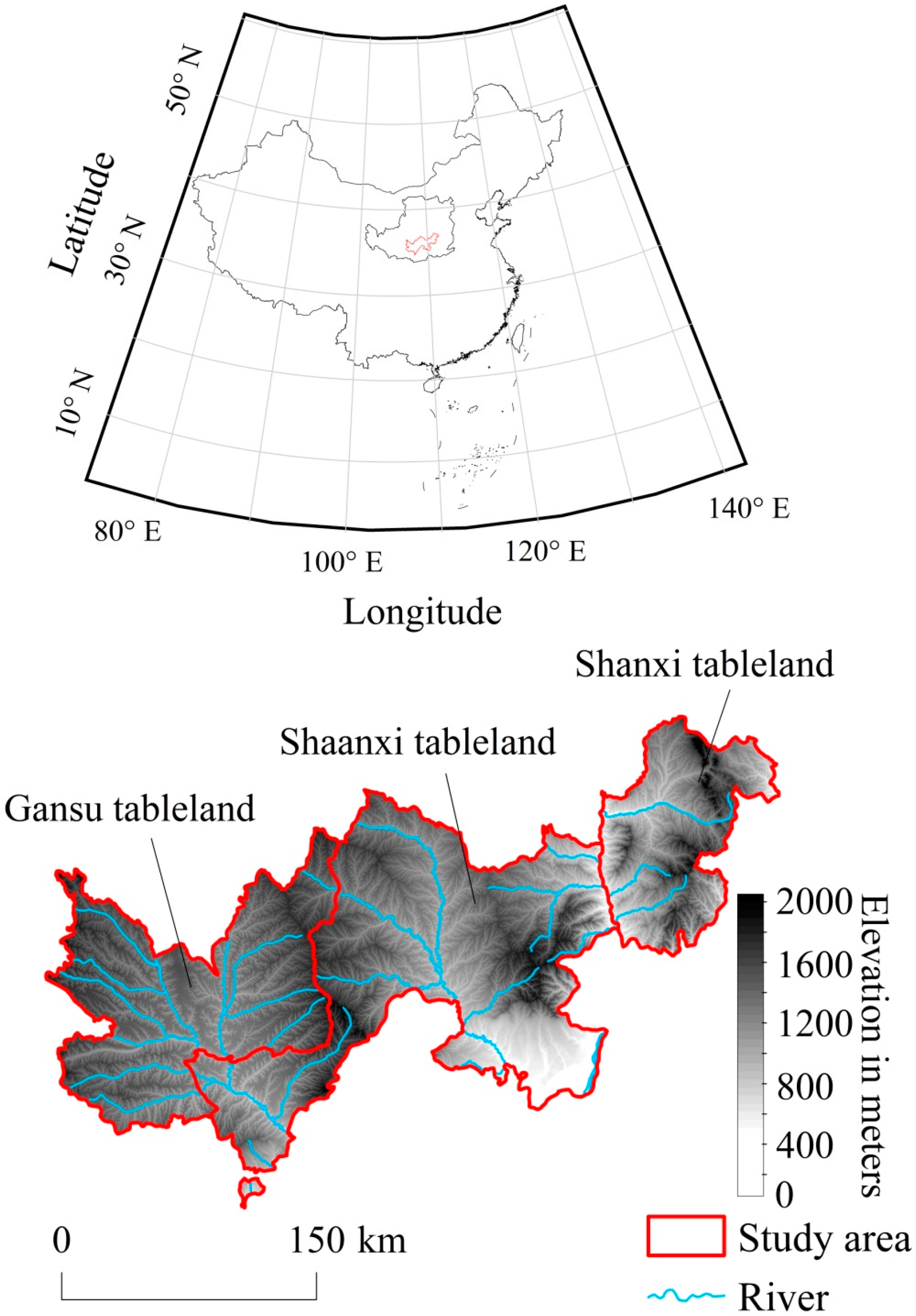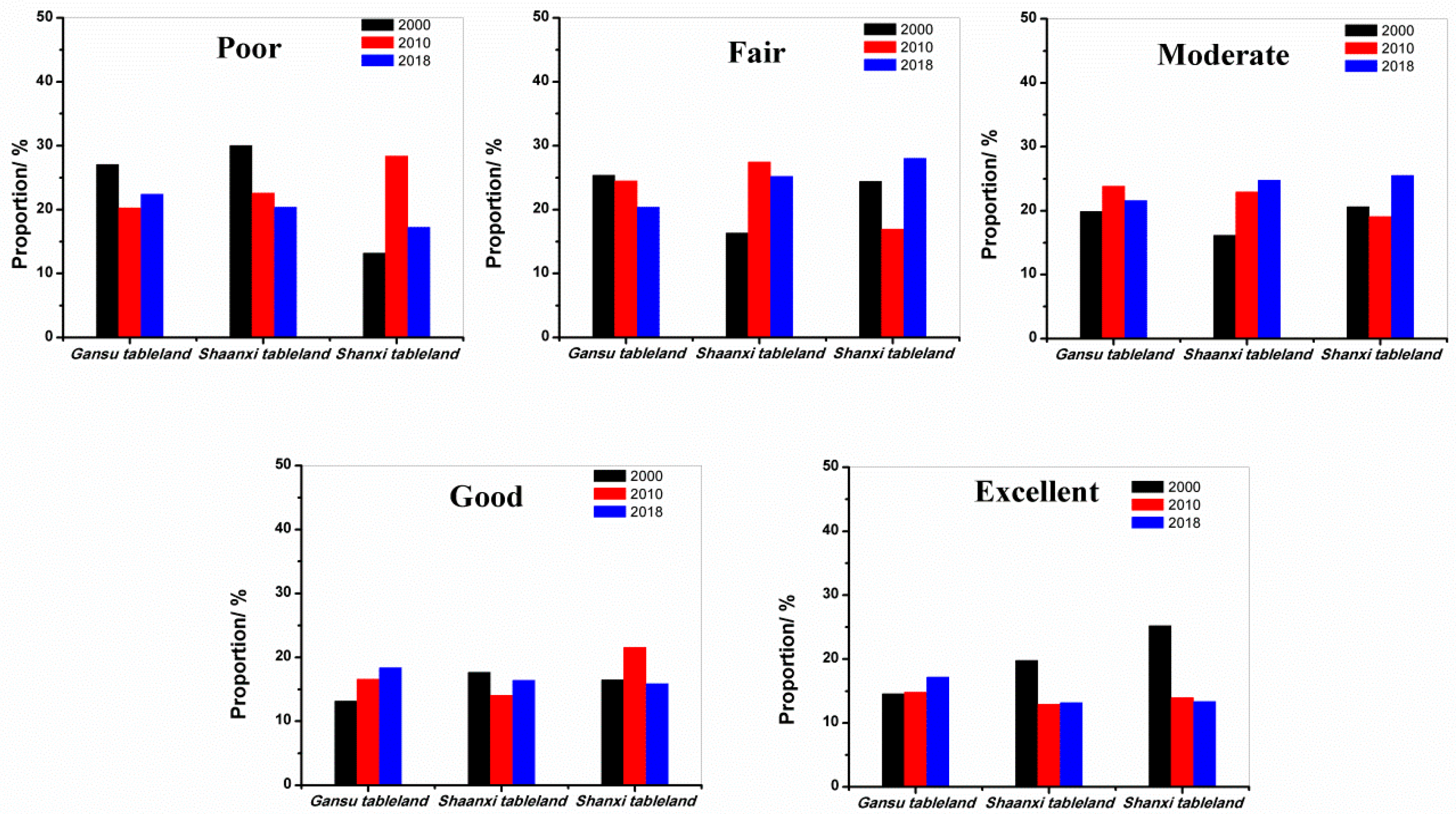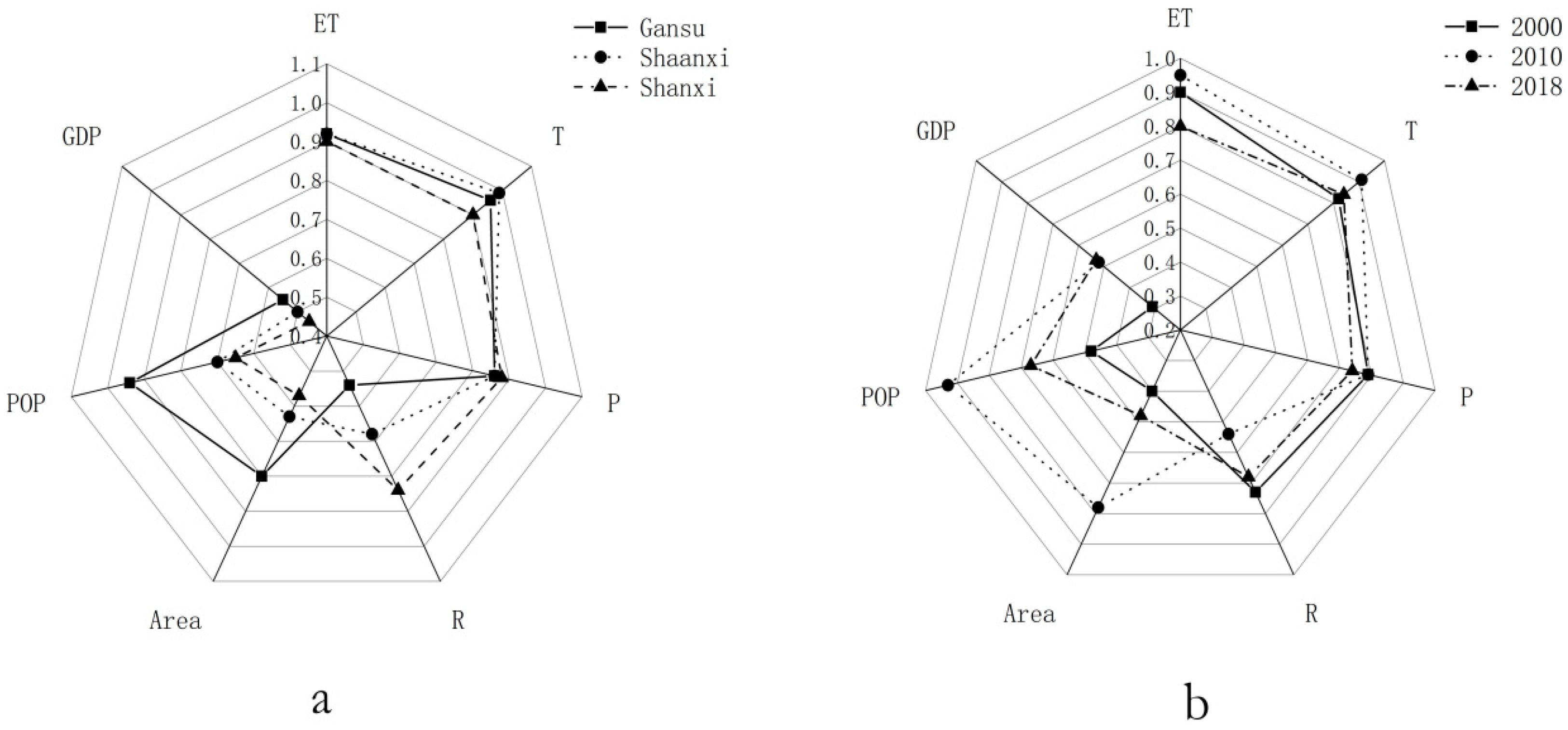Evolution of Ecological Security in the Tableland Region of the Chinese Loess Plateau Using a Remote-Sensing-Based Index
Abstract
1. Introduction
2. Study Area and Methods
2.1. Study Area
2.2. Data Sources and Pre-Processing
2.3. Calculation of Remote Sensing Ecological Index
2.3.1. Normalized Differential Vegetation Index (NDVI)
2.3.2. Land Surface Moisture (LSM)
2.3.3. Normalized Difference Built-Up and Bare-Soil Index (NDBSI)
2.3.4. Land Surface Temperature (LST)
2.3.5. Combination of the Indicators
2.3.6. Change Vector Analysis
3. Results and Discussion
3.1. Ecological Status of the Study Area
3.2. Spatiotemporal Changes in RSEI Based on the Change Vector Analysis (CVA) Method
3.3. Spatial Distribution of the Different Grade of RSEI Variation
3.4. Contributing Factors for the Regional RSEI
4. Conclusions
Author Contributions
Funding
Acknowledgments
Conflicts of Interest
References
- Li, S.; Liang, W.; Fu, B.J.; Lv, Y.H.; Fu, S.Y.; Wang, S.; Su, H.M. Vegetation changes in recent large-scale ecological restoration projects and subsequent impact on water resources in china’s loess plateau. Sci. Total Environ. 2016, 569–570, 1032–1039. [Google Scholar] [CrossRef]
- Fu, B.J.; Wang, S.; Liu, Y.; Liu, J.B.; Liang, W.; Miao, C.Y. Hydrogeomorphic ecosystem responses to natural and anthropogenic changes in the loess plateau of china. Annu. Rev. Earth Planet. Sci. 2017, 45, 223–243. [Google Scholar] [CrossRef]
- Wang, J.; Zhuo, J. Quantitative evaluation of soil erosion in returning farmland to forest area of loess plateau in north Shaanxi based on RS and GIS. Bull. Soil Water Conserv. 2015, 35, 220–223. [Google Scholar]
- Groom, G.; Mücher, C.A.; Ihse, M.; Wrbka, T. Remote sensing in landscape ecology: Experiences and perspectives in a European context. Landsc. Ecol. 2006, 21, 391–408. [Google Scholar] [CrossRef]
- Ochoa-Gaona, S.; Kampichler, C.; de Jong, B.H.J.; Hernández, S.; Geissen, V.; Huerta, E. A multi-criterion index for the evaluation of local tropical forest conditions in Mexico. For. Ecol. Manag. 2010, 260, 618–627. [Google Scholar] [CrossRef]
- Sullivan, C.A.; Skeffington, M.S.; Gormally, M.J.; Finn, J.A. The ecological status of grasslands on lowland farmlands in western Ireland and implications for grassland classification and nature value assessment. Biol. Conserv. 2010, 143, 1529–1539. [Google Scholar] [CrossRef]
- Gupta, K.; Kumar, P.; Pathan, S.K.; Sharma, K.P. Urban neighborhood green index—A measure of green spaces in urban areas. Landsc. Urban Plan. 2012, 105, 325–335. [Google Scholar] [CrossRef]
- Xu, H.Q.; Ding, F.; Wen, X. Urban expansion and heat island dynamics in the quanzhou region, china. IEEE J. Sel. Top. Appl. Earth Obs. Remote Sens. 2009, 2, 74–79. [Google Scholar] [CrossRef]
- Xu, H.Q.; Wang, Y.F.; Guan, H.D.; Shi, T.T.; Hu, X.S. Detecting Ecological Changes with a Remote Sensing Based Ecological Index (RSEI) Produced Time Series and Change Vector Analysis. Remote Sens. 2019, 11, 2345. [Google Scholar] [CrossRef]
- Ivits, E.; Cherlet, M.; Mehl, W.; Sommer, S. Estimating the ecological status and change of riparian zones in Andalusia assessed by multi-temporal AVHHR datasets. Ecol. Indic. 2009, 9, 422–431. [Google Scholar] [CrossRef]
- Caccamo, G.; Chisholm, L.A.; Bradstock, R.A.; Puotinen, M.L. Assessing the sensitivity of MODIS to monitor drought in high biomass ecosystems. Remote Sens. Environ. 2011, 115, 2626–2639. [Google Scholar] [CrossRef]
- Willis, K.S. Remote sensing change detection for ecological monitoring in United States protected areas. Biol. Conserv. 2015, 182, 233–242. [Google Scholar] [CrossRef]
- De Araujo Barbosa, C.C.; Atkinson, P.M.; Dearing, J.A. Remote sensing of ecosystem services: A systematic review. Ecol. Indic. 2015, 52, 430–443. [Google Scholar] [CrossRef]
- Rouse, J.W.; Haas, R.H.; Schell, J.A.; Deering, D.W. Monitoring vegetation systems in the Great Plains with ERTS. NASA Spec. Publ. 1973, 351, 309–317. [Google Scholar]
- Coutts, A.M.; Harris, R.J.; Phan, T.; Livesley, S.J.; Williams, N.S.G.; Tapper, N.J. Thermal infrared remote sensing of urban heat: Hotspots, vegetation, and an assessment of techniques for use in urban planning. Remote Sens. Environ. 2016, 186, 637–651. [Google Scholar] [CrossRef]
- Estoque, R.C.; Murayama, Y. Monitoring surface urban heat island formation in a tropical mountain city using Landsat data (1987–2015). ISPRS J. Photogramm. Remote Sens. 2017, 133, 18–29. [Google Scholar] [CrossRef]
- Malbéteau, Y.; Merlin, O.; Gascoin, S.; Gastellu, J.P.; Mattar, C.; Olivera-Guerra, L.; Khabba, S.; Jarlan, L. Normalizing land surface temperature data for elevation and illumination effects in mountainous areas: A case study using aster data over a steep-sided valley in morocco. Remote Sens. Environ. 2017, 189, 25–39. [Google Scholar] [CrossRef]
- Tiner, R.W. Remotely-sensed indicators for monitoring the general condition of “natural habitat” in watersheds: An application for Delaware’s Nanticoke River watershed. Ecol. Indic. 2004, 4, 227–243. [Google Scholar] [CrossRef]
- Mildrexler, D.J.; Zhao, M.S.; Running, S.W. Testing a MODIS global disturbance index across North America. Remote Sens. Environ. 2009, 113, 2103–2117. [Google Scholar] [CrossRef]
- Healey, S.P.; Cohen, W.B.; Yang, Z.Q.; Krankina, O.N. Comparison of tasseled cap-based Landsat data structures for use in forest disturbance detection. Remote Sens. Environ. 2005, 97, 301–310. [Google Scholar] [CrossRef]
- Rhee, J.; Im, J.; Carbone, G.J. Monitoring agricultural drought for arid and humid regions using multi-sensor remote sensing data. Remote Sens. Environ. 2010, 114, 2875–2887. [Google Scholar] [CrossRef]
- Xu, H.Q. A remote sensing urban ecological index and its application. Acta Ecol. Sin. 2013, 24, 7853–7862. [Google Scholar]
- Zhang, C.; Xu, H.Q.; Zhang, H.; Tang, F.; Lin, Z.L. Fractional vegetation cover change and its ecological effect assessment in a typical reddish soil region of southeastern china: Changting county, Fujian province. J. Nat. Resour. 2015, 6, 917–928. [Google Scholar]
- Yang, F.H.; Song, J.J.; Zhao, Y.R.; Zhao, J.L.; Niu, C. Dynamic monitoring of ecological environment in black soil erosion area of northeast China based on remote sensing. Res. Environ. Sci. 2018, 9, 1580–1587. [Google Scholar]
- Zhang, X.D.; Liu, X.N.; Zhao, Z.P.; Ma, Y.Y.; Yang, Y. Dynamic monitoring of ecology and environment in the agro-pastral ecotone based on remote sensing: A case of Yanchi county in Ningxia hui autonomous region. Arid Land Geogr. 2017, 5, 1070–1078. [Google Scholar]
- Fu, B.J.; Liu, Y.; Lv, Y.H.; He, C.S.; Zeng, Y.; Wu, B.F. Assessing the soil erosion control service of ecosystems change in the Loess Plateau of China. Ecol. Complex. 2011, 8, 284–293. [Google Scholar] [CrossRef]
- Lü, Y.H.; Fu, B.J.; Feng, X.M.; Zeng, Y.; Liu, Y.; Chang, R.Y.; Sun, G.; Wu, B.F. A policy-driven largescale ecological restoration: Quantifying ecosystem services changes in the loess plateau of china. PLoS ONE 2012, 7, e31782. [Google Scholar]
- Su, C.H.; Fu, B.J. Evolution of ecosystem services in the Chinese loess plateau under climatic and land use changes. Glob. Planet. Chang. 2013, 101, 119–128. [Google Scholar] [CrossRef]
- Fu, B.J.; Zhang, L.W.; Xu, Z.H.; Zhao, Y.; Wei, Y.P.; Skinner, D. Ecosystem services in changing land use. J. Soils Sediments 2015, 15, 833–843. [Google Scholar] [CrossRef]
- Sun, C.J.; Chen, W.; Chen, Y.; Cai, Z. Stable isotopes of atmospheric precipitation and its environmental drivers in the Eastern Chinese Loess Plateau, China. J. Hydrol. 2019, 581, 124404. [Google Scholar] [CrossRef]
- Lü, Y.H.; Zhang, L.W.; Feng, X.M.; Zeng, Y.; Fu, B.J.; Yao, X.L.; Wu, B.F. Recent ecological transitions in china: Greening, browning, and influential factors. Sci. Rep. 2015, 5, 8732. [Google Scholar] [CrossRef] [PubMed]
- Liang, W.; Bai, D.; Wang, F.Y.; Fu, B.J.; Yan, J.P.; Wang, S.; Yang, Y.T.; Long, D.; Feng, M.Q. Quantifying the impacts of climate change and ecological restoration on streamflow changes based on a Budyko hydrological model in china’s loess plateau. Water Resour. Res. 2015, 51, 6500–6519. [Google Scholar] [CrossRef]
- Cao, Z.; Li, Y.R.; Liu, Y.H.; Chen, Y.F.; Wang, Y.S. When and where did the Loess Plateau turn “green”? Analysis of the tendency and breakpoints of the normalized difference vegetation index. Land Degrad. Dev. 2017, 29, 162–175. [Google Scholar] [CrossRef]
- Sun, C.J.; Zheng, Z.J.; Chen, W.; Wang, Y.Y. Spatial and Temporal Variations of Potential Evapotranspiration in the Loess Plateau of China during 1960–2017. Sustainability 2020, 12, 354. [Google Scholar] [CrossRef]
- Kilic, A.; Allen, R.; Trezza, R.; Ratcliffe, I.; Kamble, B.; Robison, C.; Ozturk, D. Sensitivity of evapotranspiration retrievals from the METRIC processing algorithm to improved radiometric resolution of Landsat 8 thermal data and to calibration bias in Landsat 7 and 8 surface temperature. Remote Sens. Environ. 2016, 185, 198–209. [Google Scholar] [CrossRef]
- Xu, H.Q.; Huang, S.L.; Zhang, T.J. Built-up land mapping capabilities of the ASTER and Landsat ETM+ sensors in coastal areas of southeastern China. Adv. Space Res. 2013, 52, 1437–1449. [Google Scholar] [CrossRef]
- Hu, X.S.; Xu, H.Q. A new remote sensing index for assessing the spatial heterogeneity in urban ecological quality: A case from Fuzhou city, china. Ecol. Indic. 2018, 89, 11–21. [Google Scholar] [CrossRef]
- Yue, H.; Liu, Y.; Li, Y.; Lu, Y. Eco-Environmental Quality Assessment in China’s 35 Major Cities Based on Remote Sensing Ecological Index. IEEE Access 2019, 7, 51295–51311. [Google Scholar] [CrossRef]
- Crist, E.P. A TM Tasseled Cap equivalent transformation for reflectance factor data. Remote Sens. Environ. 1985, 17, 301–306. [Google Scholar] [CrossRef]
- Baig, M.H.A.; Zhang, L.F.; Shuai, T.; Tong, Q.X. Derivation of a tasseled cap transformation based on Landsat 8 at-satellite reflectance. Remote Sens. Lett. 2014, 5, 423–431. [Google Scholar] [CrossRef]
- Rikimaru, A.; Roy, P.S.; Miyatake, S. Tropical forest cover density mapping. Trop. Ecol. 2002, 43, 39–47. [Google Scholar]
- Xu, H.Q. A new index-based built-up index (IBI) and its eco-environmental significance. Remote Sens. Technol. Appl. 2017, 3, 301–308. [Google Scholar]
- Chander, G.; Markham, B.L.; Helder, D.L. Summary of current radiometric calibration coefficients for Landsat MSS, TM, ETM+, and EO-1 ALI sensors. Remote Sens. Environ. 2009, 113, 893–903. [Google Scholar] [CrossRef]
- Sobrino, J.A.; Jiménez-Muñoz, J.C.; Paolini, L. Land surface temperature retrieval from LANDSAT TM 5. Remote Sens. Environ. 2004, 90, 434–440. [Google Scholar] [CrossRef]
- Li, P. Research on Information Extraction Method of Vegetation Coverage Change Based on CVA; Capital Normal University: Beijing, China, 2011. [Google Scholar]
- Dewi, R.S.; Bijker, W.; Stein, A. Change vector analysis to monitor the changes in fuzzy shorelines. Remote Sens. 2017, 9, 147. [Google Scholar] [CrossRef]
- Xu, H.Q.; Wang, M.Y.; Shi, T.T.; Guan, H.D.; Fang, C.Y.; Lin, Z.L. Prediction of ecological effects of potential population and impervious surface increases using a remote sensing based ecological index (RSEI). Ecol. Indic. 2018, 93, 730–740. [Google Scholar] [CrossRef]
- Huang, J.T.; Liao, Y.S. Optimization of machining parameters of Wire-EDM based on Grey relational and statistical analyses. Int. J. Prod. Res. 2003, 41, 1707–1720. [Google Scholar] [CrossRef]
- Huang, Z.B.; Xu, M.; Chen, W.; Lin, X.J.; Cao, C.X.; Ramesh, P.S. Postseismic restoration of the ecological environment in the Wenchuan region using satellite data. Sustainability 2018, 10, 3990. [Google Scholar] [CrossRef]






| Tableland Regions | Path/Row | Data Times | Sensor Types |
|---|---|---|---|
| Gansu tableland | 127/035 | 2000.10.01 | TM |
| 2010.10.20 | |||
| 2018.10.16 | OLI | ||
| 127/036 | 2000.10.01 | TM | |
| 2010.10.20 | |||
| 2018.10.10 | OLI | ||
| 128/035 | 2000.10.08 | TM | |
| 2010.10.20 | |||
| 2018.10.12 | OLI | ||
| 128/036 | 2000.10.08 | TM | |
| 2010.10.20 | |||
| 2018.10.12 | OLI | ||
| Shanxi tableland | 125/035 | 2000.10.03 | TM |
| 2010.10.22 | |||
| 2018.10.26 | OLI | ||
| 126/034 | 2000.10.26 | TM | |
| 2010.10.26 | |||
| 2018.10.04 | OLI | ||
| 126/035 | 2000.10.26 | TM | |
| 2010.10.29 | |||
| 2018.10.04 | OLI | ||
| Shaanxi tableland | 126/035 | 2000.10.26 | TM |
| 2010.10.29 | |||
| 2018.10.04 | OLI | ||
| 126/036 | 2000.10.26 | TM | |
| 2010.10.13 | |||
| 2018.10.30 | OLI | ||
| 127/035 | 2000.10.01 | TM | |
| 2010.10.20 | |||
| 2018.10.16 | OLI | ||
| 127/036 | 2000.10.01 | TM | |
| 2010.10.20 | |||
| 2018.10.26 | OLI | ||
| 128/036 | 2000.10.08 | TM | |
| 2010.10.20 | |||
| 2018.10.12 | OLI |
| Periods | Regions | Types | NDBSI | LST | NDVI | LSM | RSEI |
|---|---|---|---|---|---|---|---|
| 2000 | Gansu tableland | Average value | 0.62 | 0.51 | 0.38 | 0.48 | 0.43 |
| PC1 loading | 0.49 | 0.48 | −0.49 | −0.54 | |||
| Shaanxi tableland | Average value | 0.56 | 0.27 | 0.31 | 0.30 | 0.45 | |
| PC1 loading | −0.52 | −0.39 | 0.55 | 0.53 | |||
| Shanxi tableland | Average value | 0.60 | 0.45 | 0.60 | 0.60 | 0.54 | |
| PC1 loading | 0.56 | 0.42 | −0.54 | −0.47 | |||
| 2010 | Gansu tableland | Average value | 0.57 | 0.75 | 0.51 | 0.44 | 0.46 |
| PC1 loading | 0.57 | 0.37 | −0.58 | −0.46 | |||
| Shaanxi tableland | Average value | 0.63 | 0.55 | 0.51 | 0.47 | 0.43 | |
| PC1 loading | −0.56 | −0.40 | 0.47 | 0.56 | |||
| Shanxi tableland | Average value | 0.72 | 0.59 | 0.74 | 0.64 | 0.44 | |
| PC1 loading | −0.54 | −0.43 | 0.26 | 0.67 | |||
| 2018 | Gansu tableland | Average value | 0.60 | 0.52 | 0.49 | 0.50 | 0.47 |
| PC1 loading | 0.57 | 0.38 | −0.43 | −0.59 | |||
| Shaanxi tableland | Average value | 0.53 | 0.69 | 0.53 | 0.51 | 0.45 | |
| PC1 loading | 0.58 | 0.08 | −0.53 | −0.61 | |||
| Shanxi tableland | Average value | 0.74 | 0.54 | 0.56 | 0.80 | 0.46 | |
| PC1 loading | 0.67 | 0.58 | −0.25 | −0.38 |
| Level | Interval | Gansu Tableland/% | Shaanxi Tableland/% | Shanxi Tableland/% | |||
|---|---|---|---|---|---|---|---|
| 2010–2000 | 2018–2010 | 2018–2000 | 2010–2000 | 2010–2000 | 2010–2000 | ||
| Significant degraded region | −1–−0.2 | 17.65 | 20.75 | 21.02 | 21.85 | 26.69 | 11.92 |
| Degraded region | −0.2–−0.05 | 20.95 | 16.46 | 21.78 | 18.53 | 37,44 | 21.72 |
| Stable region | −0.05–0.05 | 19.02 | 17.39 | 21.77 | 16.85 | 20.77 | 24.6 |
| Improved region | 0.05–0.2 | 18.13 | 18.12 | 18.74 | 18.16 | 11.23 | 25.46 |
| Significant improved region | 0.2–1 | 24.25 | 27.28 | 16.70 | 24.61 | 3.86 | 16.3 |
© 2020 by the authors. Licensee MDPI, Basel, Switzerland. This article is an open access article distributed under the terms and conditions of the Creative Commons Attribution (CC BY) license (http://creativecommons.org/licenses/by/4.0/).
Share and Cite
Sun, C.; Li, X.; Zhang, W.; Li, X. Evolution of Ecological Security in the Tableland Region of the Chinese Loess Plateau Using a Remote-Sensing-Based Index. Sustainability 2020, 12, 3489. https://doi.org/10.3390/su12083489
Sun C, Li X, Zhang W, Li X. Evolution of Ecological Security in the Tableland Region of the Chinese Loess Plateau Using a Remote-Sensing-Based Index. Sustainability. 2020; 12(8):3489. https://doi.org/10.3390/su12083489
Chicago/Turabian StyleSun, Congjian, Xiaoming Li, Wenqiang Zhang, and Xingong Li. 2020. "Evolution of Ecological Security in the Tableland Region of the Chinese Loess Plateau Using a Remote-Sensing-Based Index" Sustainability 12, no. 8: 3489. https://doi.org/10.3390/su12083489
APA StyleSun, C., Li, X., Zhang, W., & Li, X. (2020). Evolution of Ecological Security in the Tableland Region of the Chinese Loess Plateau Using a Remote-Sensing-Based Index. Sustainability, 12(8), 3489. https://doi.org/10.3390/su12083489





